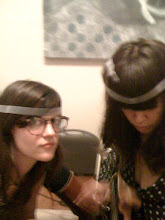
A screening and conversation was held last night at Electronic Arts Intermix in celebration of the new book An Art of Limina: Gary Hill's Works and Writings. A panel consisting of Gary Hill, George Quasha and Charles Stein (authors of the publication) illuminated and discussed a selection of Hill's early single-channel videos, such as Around & About, Sums and Differences, Happenstance (part one of many parts), Tale Enclosures, and Why Do Things Get in a Muddle (Come on Petunia). Hill, Quasha, and Stein have collaborated for the greater part of the last three decades on this book and as artists. This created a formidable atmosphere where the three fluidly reminisced, shared memories and theoretical outlooks alike. At one point Charles Stein random broke out into semantic gibberish, concluding that through abstract primal expression, he could in fact create his own system of believable linguistics which convey a message. (A perfect segway into Hill's 1985 work Tale Enclosures where Quasha and Stein are taped performing rhythmic chants.)
Quasha gave a brief intro about the book, describing Stein and his efforts as enabling the "Further life of the work."
"Our primary interest is in what we call the further life of the work, which we have defined as an extension of the creative energy and interest that the work itself actually projects through its own instance. We will have more to say on this subject in the Prologue and elsewhere, as it speaks to something in Gary Hill’s work itself, as we see it. In short, we intend that our writing about his work contribute to the very possibility which the work opens up. The theory is that critical alignment with a work brings that work out, brings it forward to possible participation. The further life is also an active dialogue with the ongoing work itself."
I couldn't agree more with this perspective. The articulation and recognition of critical engagement and dialogue as a way of extending and facilitating a work's future agency is rarely specified, eventhough it is implicit in the act of writing. The articulation of this notion means a lot.
Much of the book's contents, including the forward by Lynne Cook, can be found here.
I was also interested Quasha's belief that all concepts are working towards defining a principle, the latter of which cannot be quantified or defined, but only approached through various avenues and forms of access. A conversation with Quasha after the event revealed an interesting video project that he is conducting, entitled "Art is." His website describes the project:
"In this ongoing video work of speaking portraits begun in 2002, I put this impossible, but inevitable, question before other artists, poets, musicians…. Result: a close-up of the normally private space of art definition. To date some 800 artists of all kinds–sculptors, painters, filmmakers, video artists, poets, composers, performance artists, and so on–have been recorded in eleven countries and twenty-four languages. This ongoing and constantly changing work in multiple series- Art is- Music is- Poetry is- has been exhibited primarily as installations, but now online as single-channel works. This is just the beginning–and by it’s nature it will always just be beginning. The is the space of saying the impossible–a mission always in need of a poetics."
art is [Vol. I] from George Quasha on Vimeo.










